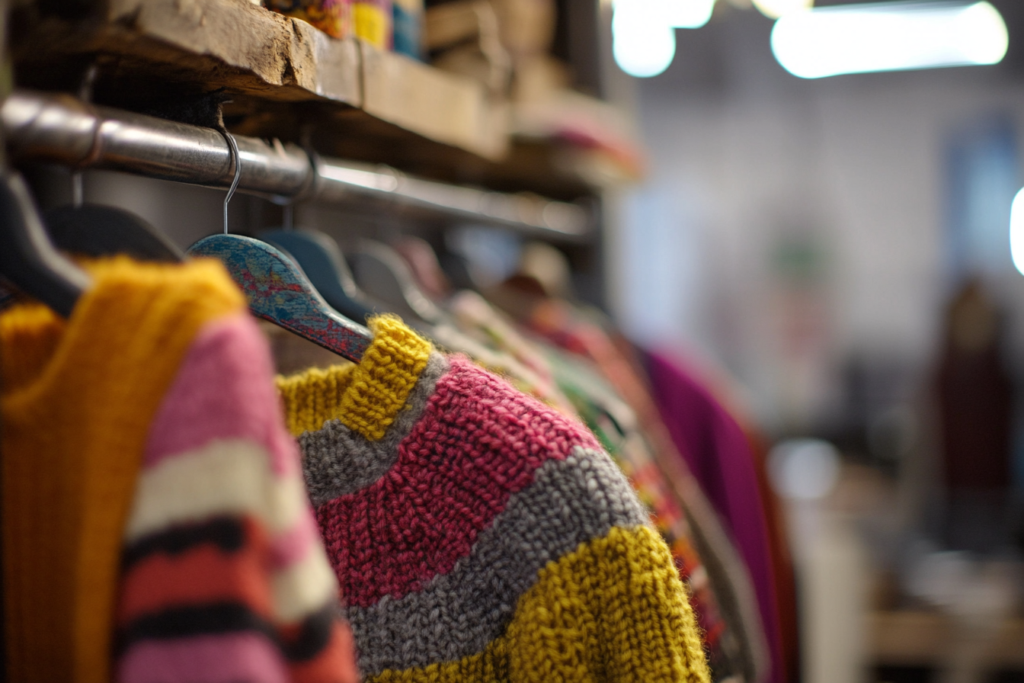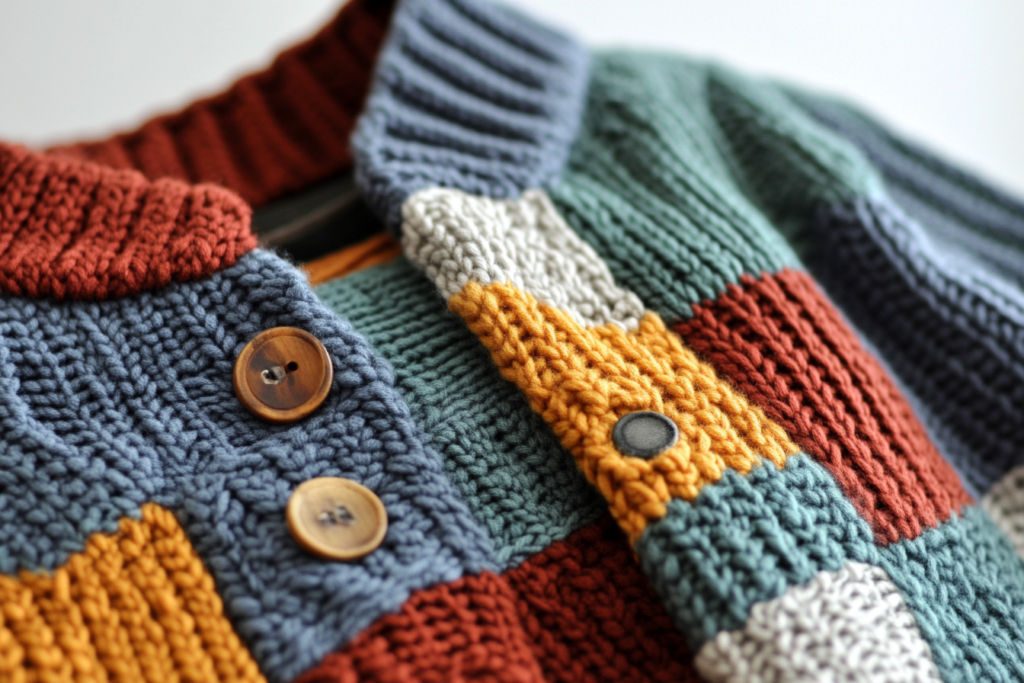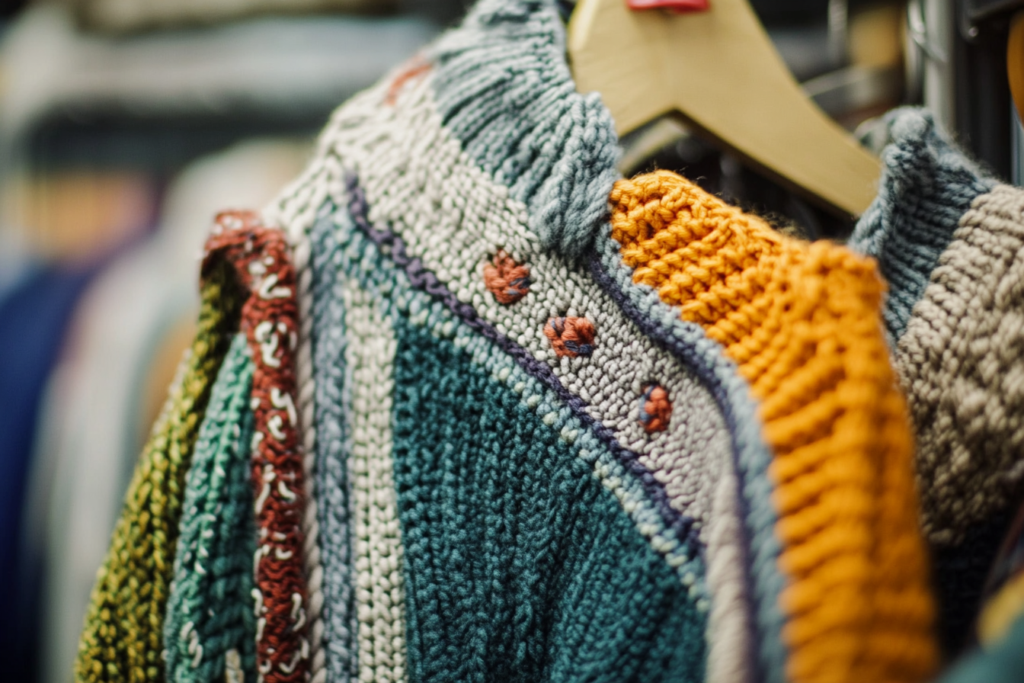Introduction: What is Cut-and-Sew?
Cut-and-sew is a method of manufacturing knitted garments that involves cutting pieces of fabric from knitted material and sewing them together to create a finished product. This process differs from fully fashioned knitting, where the garment is knitted in one piece with no additional cutting or stitching required. The cut-and-sew technique allows for greater flexibility in terms of design and sizing, making it a popular choice for mass production of knitwear.
This method is especially used for garments that require shaping or structural seams, such as t-shirts, sweatshirts, and other knit-based clothing. While fully fashioned knitting produces garments with intricate, seamless designs, cut-and-sew allows designers and manufacturers to have more control over the cut, fit, and overall construction of the garment.


How Cut-and-Sew Works
- Knitting the Fabric:
- The first step in the cut-and-sew process is knitting the fabric, typically on a circular knitting machine. This fabric is knitted in large rolls or pieces that can be cut into specific shapes for the garment. The fabric produced can vary in thickness, texture, and elasticity depending on the desired final product.
- Cutting the Pieces:
- Once the fabric is knitted, it is cut into specific shapes that will make up the various parts of the garment, such as sleeves, body panels, and collars. The cutting process is precise to ensure that each piece fits correctly when sewn together. The pieces may be cut manually or using automated cutting machines.
- Sewing the Pieces Together:
- After the fabric pieces are cut, they are sewn together, often using industrial sewing machines. The sewing process involves joining the pieces with seams that are strong and secure, typically using a stretch stitch to accommodate the elasticity of the knitted fabric. This method allows for multiple design possibilities, including custom fits and detailing.
- Finishing Touches:
- After the garment is assembled, finishing techniques such as hemming, adding labels, or applying additional trim may be done. The garment is then inspected for quality and packed for shipment or retail.
Benefits of the Cut-and-Sew Method
- Flexibility in Design:
- One of the main advantages of the cut-and-sew method is the flexibility it provides in terms of design. Since the pieces are cut from knitted fabric, designers can create a wide variety of shapes, sizes, and styles. This method also allows for greater creativity in combining different fabrics, textures, and colors.
- Faster Production:
- Cut-and-sew garments can be produced quickly compared to fully fashioned garments. This is because the fabric is knitted first and then cut and sewn, rather than being knitted into the final garment shape. The production process can be streamlined, making it ideal for mass production in the fashion industry.
- Cost-Effective:
- Cut-and-sew is a more cost-effective method compared to fully fashioned knitting. The ability to knit large rolls of fabric and cut them into pieces allows for the efficient use of materials. Additionally, the method does not require the same level of skilled labor or specialized machines that fully fashioned knitting does, which helps reduce production costs.
- Versatility:
- The cut-and-sew method is versatile enough to be used for a wide range of garments, from casual wear like t-shirts and sweaters to more tailored pieces. It also allows for customization in terms of size and fit, making it suitable for both standard and bespoke clothing.
Cut-and-Sew vs. Fully Fashioned Knitting
While both cut-and-sew and fully fashioned knitting involve creating knitted garments, there are key differences between the two methods:
- Fully Fashioned Knitting:
- In fully fashioned knitting, the garment is knitted directly into its final shape. This means that no cutting or additional seams are required. The knitting machine creates the garment with the desired shaping and detailing, which results in a seamless piece of clothing. This method is often used for high-quality, custom-made garments.
- Cut-and-Sew:
- With cut-and-sew, the fabric is knitted first, then cut into pieces and sewn together. This method is often used for mass-produced clothing and provides more flexibility in terms of fabric choice, design, and production speed. It’s typically seen in more casual or ready-to-wear fashion.
Common Applications of Cut-and-Sew
- Casual Wear:
- Cut-and-sew is most commonly used for casual wear, including t-shirts, sweatshirts, and activewear. The flexibility of the method allows for the creation of garments with various necklines, sleeve styles, and body shapes.
- Sportswear and Activewear:
- Activewear and sportswear often use the cut-and-sew method to achieve the desired fit and comfort. The ability to knit fabric that provides stretch and then cut it into precise shapes makes it ideal for creating garments that require flexibility and performance.
- Fashion and Ready-to-Wear:
- Many fashion brands utilize the cut-and-sew technique in their ready-to-wear collections. The method allows for fast, large-scale production of garments that are stylish and affordable. Designers can also experiment with different textures, prints, and patterns by cutting and sewing knitted fabric.
- Custom Garments:
- For custom-made garments, cut-and-sew allows for greater control over sizing and design. While fully fashioned knitting is typically used for high-end, bespoke pieces, cut-and-sew provides a more accessible option for creating custom-fit clothing.
Conclusion: The Versatility of Cut-and-Sew in Knitted Garments
The cut-and-sew method is a versatile, cost-effective, and efficient way to produce knitted garments. By knitting the fabric first and then cutting and sewing it into specific shapes, this method offers both designers and manufacturers the ability to create a wide variety of styles and fits. Whether used for casual wear, activewear, or fashion garments, cut-and-sew continues to be a popular choice in the garment industry.



